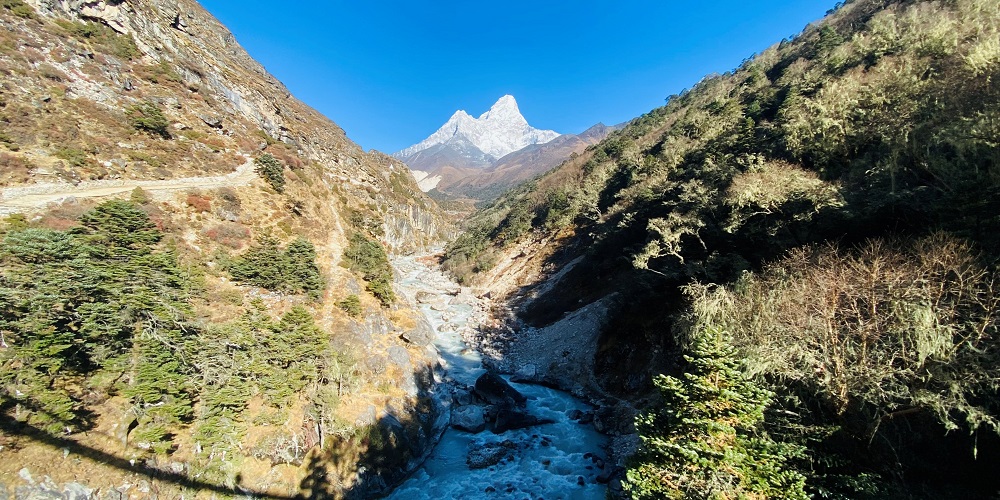Interesting things about Dudh Koshi | All you need to know about Dudh Koshi River
The Dudh Koshi River is a significant waterway in the Khumbu region of Nepal, known for its stunning beauty and importance in the Everest region. Here are some interesting things about the Dudh Koshi River:
1. Glacial Origin:
The Dudh Koshi River originates from the melting glaciers of the Everest region. As the glaciers melt, the water collects and forms small streams and rivulets that eventually merge to create the Dudh Koshi River. The glacial meltwater carries fine particles of rock flour, which gives the river its milky-white appearance.
2. Name Meaning:
The name "Dudh Koshi" translates to "Milk River" in English. The name accurately reflects the river's appearance, as it resembles flowing milk due to the suspended particles of rock flour. The white coloration of the river is most prominent during the spring and summer months when the glacial meltwater is at its highest.
3. Flow and Tributaries:
The Dudh Koshi River winds its way through the Solu-Khumbu District in Nepal. It flows through various valleys, including the Dudh Koshi Valley, which is a popular trekking route in the Everest region. Along its course, the river receives contributions from several tributaries, such as the Imja Khola, Bhote Koshi, and streams originating from the Gokyo Lakes.
4. Everest Base Camp Trek Crossing:
The Dudh Koshi River is a significant feature encountered by trekkers on the Everest Base Camp trek. Numerous sturdy suspension bridges span the river, allowing trekkers to safely cross from one side to the other. These bridges, including the famous Hillary Suspension Bridge, are not only functional but also offer breathtaking views of the rushing river and the surrounding mountains.
5. Sherpa Culture and Livelihood:
The Dudh Koshi River holds great cultural significance for the Sherpa people who inhabit the Everest region. It is considered a lifeline for the Sherpa communities, providing them with water for drinking, irrigation of fields, and the generation of hydropower. The Sherpa people have developed a deep connection with the river, and their cultural practices and way of life are often centered around it.
6. Scenic Beauty:
The Dudh Koshi River flows through stunning valleys, surrounded by towering Himalayan peaks, lush forests, and terraced fields. As trekkers follow the trail along the river, they are treated to breathtaking vistas at every turn. The contrasting colors of the milky-white river against the vibrant greenery and snow-capped mountains create a truly mesmerizing landscape.
7. Ecological Importance:
The Dudh Koshi River supports a diverse ecosystem and plays a vital role in the region's ecology. The surrounding valleys and forests are home to various plant and animal species, including numerous bird species, butterflies, and mammals like musk deer and Himalayan tahr. The river provides essential water sources and habitats for these organisms, contributing to the overall biodiversity of the region.
8. Hydropower Potential:
The fast-flowing waters of the Dudh Koshi River possess significant hydropower potential. Over the years, hydroelectric projects have been developed along the river to harness its energy and generate electricity for local communities and trekking infrastructure. These projects contribute to sustainable energy sources and provide power to the remote mountainous areas.
9. Rafting and Kayaking:
The Dudh Koshi River offers thrilling opportunities for water-based adventure activities such as rafting and kayaking. Adventurous individuals can navigate the river's rapids, enjoying an adrenaline-filled experience amidst the stunning Himalayan scenery. Rafting and kayaking trips on the Dudh Koshi River provide a unique perspective of the region's natural beauty and are popular among adventure enthusiasts.
10. Cultural Significance:
The Dudh Koshi River holds cultural importance for the local Sherpa community. The river is considered sacred, and various religious rituals and ceremonies are performed along its banks. Sherpa festivals and traditions often involve paying homage to the river, demonstrating the deep spiritual connection between the people and the natural elements of their environment.
In summary, the Dudh Koshi River is not only a stunning natural feature but also a vital component of the Everest region's cultural and ecological fabric. Its glacial origin, milky-white appearance, cultural significance, and role in sustaining the local communities make it a fascinating aspect of the Khumbu region's natural heritage.




.jpg)



